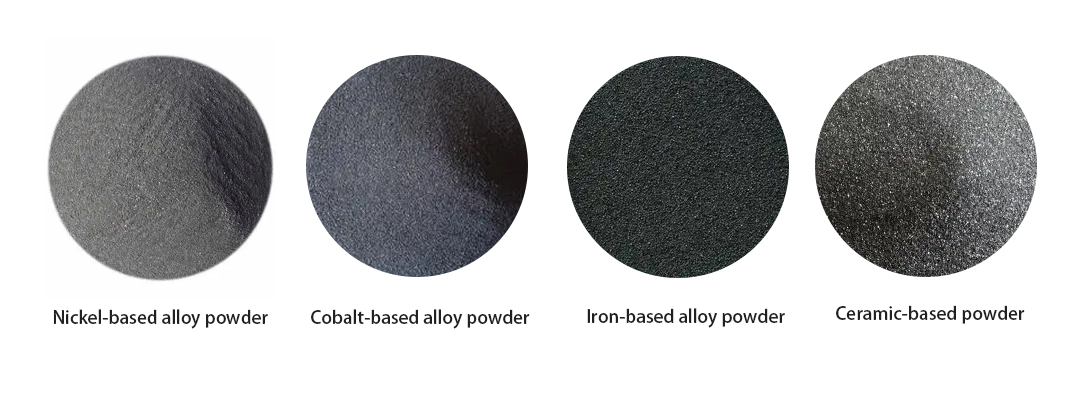1.1 Definition von Verkleidung
Die Plattierung ist ein Oberflächenmodifizierungsverfahren, das hauptsächlich dazu dient, eine Schicht mit spezifischen Eigenschaften auf der Oberfläche eines Substrats aufzubringen, um dessen Verschleißfestigkeit, Korrosionsbeständigkeit und Hochtemperaturverhalten zu verbessern. Beim Plattieren werden Metall- oder Legierungspulver und andere Materialien mittels Laser, Lichtbogen, Plasma oder ähnlichen Verfahren erhitzt, bis sie geschmolzen sind, und mit der Substratoberfläche zu einer festen Beschichtung verschmolzen. Zwischen der Plattierungsschicht und dem Grundmaterial besteht üblicherweise eine metallurgische Bindung, die eine hohe Haftung der Beschichtung gewährleistet.
Anwendungsgebiete von Verkleidungen
Die Fassadentechnologie findet breite Anwendung in
• Petrochemikalien
• Luft- und Raumfahrt
•Automobil
•Schimmel
• Metallurgie
Metallurgie und viele andere Bereiche.
Die Beschichtungstechnologie dient der Reparatur und Verbesserung mechanischer Bauteile. Hauptziel ist die Verlängerung der Lebensdauer der Teile, die Reduzierung von Verschleiß und Korrosionsschäden sowie die Möglichkeit, die Oberfläche in kurzer Zeit zu modifizieren.
Arten von Fassadenverkleidungen
Durch die Nutzung eines hochenergetischen Laserstrahls zum Erhitzen des Mantelmaterials wird eine hohe Präzision und eine kleine Wärmeeinflusszone erreicht.
Durch die Nutzung der Plasmabogenheizung eignet es sich für die Bearbeitung dickerer Beschichtungen und großer Werkstücke.
3. Lichtbogenplattierung
Durch Erhitzung mittels Lichtbogen, geringere Kosten, häufig verwendet bei der Oberflächenverstärkung großer Bauteile.
4. Flammspritzen von Fassadenverkleidungen
Durch Aufsprühen des Beschichtungsmaterials auf die Oberfläche des Substrats mittels einer Flamme wird hauptsächlich Schutzbeschichtungen mit niedriger und mittlerer Festigkeit hergestellt.
Die wichtigsten Vorteile der Fassadenverkleidungstechnologie
1. Verbesserung der Materialeigenschaften: Es ist möglich, die gewünschten Eigenschaften (z. B. Abrieb- und Korrosionsbeständigkeit) auf der Oberfläche des Substrats zu erzielen.
2. Reduzierter Materialverbrauch: Es muss nur die Oberfläche verkleidet werden, wodurch der Einsatz teurer Materialien reduziert wird.
3. Verlängerte Lebensdauer der Geräte: Verbessert die Lebensdauer der Geräteteile erheblich und reduziert die Wartungshäufigkeit.
4. Umweltfreundlich und wirtschaftlich: Verringert den Bedarf an herkömmlichen Ersatzteilen und spart so Kosten und Ressourcen.
Schritte der Fassadenverkleidung
•Materialvorbereitung: Auswahl eines geeigneten Verkleidungsmaterials, wie z. B. Metall.Pulver, Legierungspulver oder Keramik.
•Erhitzen und Verschmelzen: Das Hüllmaterial wird mithilfe einer Wärmequelle bis zum geschmolzenen Zustand erhitzt.
•Beschichtung und Verschmelzung: Bildung einer metallurgisch gebundenen Beschichtung auf der Oberfläche des verschmolzenen Materials und des Substrats.
•Abkühlung und Verfestigung: Nach der Abkühlung verfestigt sich das Beschichtungsmaterial auf der Oberfläche des Substrats und bildet eine Beschichtung mit spezifischen Eigenschaften.
Das Plattieren ist ein hocheffizientes und kostengünstiges Verfahren zur Oberflächenveredelung, das die Funktionalität der Oberfläche verbessert und gleichzeitig die Eigenschaften des Substrats erhält. Verschiedene Plattiertechnologien wie Laser-, Plasma- und Lichtbogenplattieren haben jeweils ihre spezifischen Anwendungsbereiche und Eigenschaften. Das geeignete Verfahren wird üblicherweise anhand der Prozessanforderungen und Materialeigenschaften ausgewählt.
1.2 Über Verschleißlösungen
Verschleiß bezeichnet den Materialverlust mechanischer Teile durch Reibung im Langzeitbetrieb und beeinträchtigt deren Leistung und Lebensdauer. Um dem Verschleißproblem entgegenzuwirken, müssen je nach Situation unterschiedliche Lösungsansätze gewählt werden.
Was ist eine Verschleißlösung?
Verschleißschutzlösungen sind terminologisch so konzipiert, dass sie den durch Reibung verursachten Materialverlust in einer bestimmten Maschine oder einem bestimmten Gerät minimieren.
Arten und Varianten von Verschleiß
Verschleiß lässt sich je nach Situation auf unterschiedliche Weise kategorisieren. Das Verständnis der verschiedenen Verschleißarten hilft Ihnen, den Verschleiß Ihrer Maschine oder Anlage zu erkennen und so eine optimale Verschleißschutzlösung für Ihre Bedürfnisse zu finden!
1. Abrasiver Verschleiß
Abrasiver Verschleiß ist der Materialverlust, der durch die Bewegung harter Partikel (Abrasivkörner) zwischen sich berührenden Oberflächen oder im Material selbst verursacht wird. Abrasive Partikel können Fremdkörper sein, die von außen eindringen, oder Abrieb, der während des Verschleißprozesses vom Material selbst entsteht.
- Merkmale: Bildung von Grübchen, Kratzern oder plastischer Verformung auf der Oberfläche des Materials.
2. Klebstoffverschleiß
Adhäsionsverschleiß bezeichnet das mikroskopische Verschweißen und anschließende Aufreißen zweier Materialien, die sich bei Relativbewegung berühren, was zu Materialübertragung oder -verlust führt. Hohe Temperaturen oder Drücke an den Kontaktflächen verstärken diesen Verschleiß häufig.
- Merkmale: Mikroskopische Schweiß- und Rissspuren auf den Materialoberflächen, möglicher Materialtransfer.
3. Ermüdungsverschleiß
Ermüdungsverschleiß entsteht durch Spannungskonzentrationen infolge wiederholter Belastungen an den Kontaktflächen. Dies führt zu Mikrorissen im Oberflächenmaterial und schließlich zu Materialabplatzungen. Ermüdungsverschleiß tritt hauptsächlich an Bauteilen auf, die zyklischen Belastungen ausgesetzt sind.
- Merkmale: Kleine Risse oder abblätternde Partikel an der Oberfläche, die auf Lochfraß oder Abplatzungen der Haut hinweisen.
4. Korrosionsverschleiß
Unter korrosivem Verschleiß versteht man den Materialverschleiß im Reibungsprozess aufgrund chemischer oder elektrochemischer Reaktionen, die durch Korrosion verursacht werden und in Verbindung mit der verstärkten Ablösung von Korrosionsprodukten durch Reibung zu einem beschleunigten Materialverlust führen.
- Merkmale: Die Verschleißoberfläche weist Oxidationsspuren, Rost oder Korrosionsnarben auf.
Verschiedene Verschleißarten unterscheiden sich in ihren Mechanismen, Eigenschaften und Gegenmaßnahmen. Gängige Lösungen umfassen die Auswahl verschleißfester Werkstoffe, Oberflächenbehandlung, Schmierung, Strukturoptimierung und Umgebungsmanagement. Das Verständnis der Verschleißarten und -eigenschaften ermöglicht gezieltere Schutzmaßnahmen zur Verlängerung der Lebensdauer Ihrer Bauteile.
Anwendungsbereiche für Verschleißlösungen
•Herstellung
•Bergwerke und Bergbau
•Öl und Gas
•Strom und Energie
•Automobilindustrie
•Bau- und Maschinenbaumaschinen
•Luft- und Raumfahrt
•Landmaschinen
•Schiffsmaschinenbau
Lösungen für Verkleidung und Verschleiß
Die Plattierung, ein gängiges Oberflächentechnikverfahren, spielt eine wichtige Rolle bei der Verschleißminderung. Durch das Aufbringen verschleißfester Materialien auf die Oberfläche eines Substrats lassen sich Verschleißfestigkeit, Korrosionsbeständigkeit und Schlagfestigkeit deutlich verbessern und somit die Lebensdauer des Bauteils verlängern.
Die Rolle der Beschichtung in Verschleißlösungen
1. Verbesserte Verschleißfestigkeit: Beschichtungsmaterialien weisen typischerweise eine hohe Härte und Verschleißfestigkeit auf, was den Verschleiß in Umgebungen mit hoher Verschleißbelastung reduziert.
2. Verbesserte Korrosionsbeständigkeit: Einige spezielle Verkleidungsmaterialien sind chemisch beständig und eignen sich daher für den Einsatz in korrosiven Umgebungen wie nassen, sauren, alkalischen oder maritimen Umgebungen.
3. Verlängerung der Lebensdauer: Durch die Bildung einer hochverschleißfesten Beschichtung auf der Oberfläche des Substrats wird die Lebensdauer der Geräte und Teile effektiv verlängert und die Häufigkeit von Wartung und Austausch reduziert.
4. Verbesserung der Schlagfestigkeit: Einige Legierungsbeschichtungsmaterialien weisen eine gute Zähigkeit auf, wodurch die Beschädigung der Bauteiloberfläche durch Stöße reduziert werden kann. Sie eignen sich daher für Geräte, die eine hohe Schlagfestigkeit erfordern.
Wo kann man Verschleißlösungen erhalten?
Es gibt viele Unternehmen und Organisationen, die Lösungen für Verschleißprobleme anbieten. Wenn Sie jedoch den besten Service suchen, zögern Sie nicht, mit ShanghaiDuomu zusammenzuarbeiten. Wir sind führend in China und unangefochten an der Spitze. Viele Unternehmen halten uns für den kompetentesten Anbieter von Verschleißlösungen in China. Für die optimale Verschleißlösung kontaktieren Sie uns.Kontaktieren Sie unsUm erstklassigen Service von den professionellsten Ingenieuren zu erhalten!
Veröffentlichungsdatum: 05.11.2024








